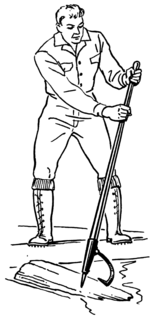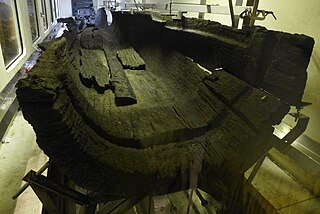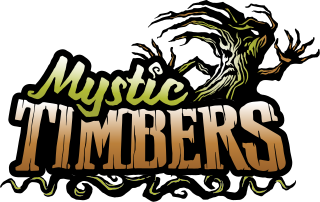
Logging is the process of cutting, processing, and moving trees to a location for transport. It may include skidding, on-site processing, and loading of trees or logs onto trucks or skeleton cars.
A toboggan is a simple sled traditionally used by children. It is also a traditional form of transport used by the Innu and Cree of northern Canada.

A skidder is any type of heavy vehicle used in a logging operation for pulling cut trees out of a forest in a process called "skidding", in which the logs are transported from the cutting site to a landing. There they are loaded onto trucks, and sent to the mill. One exception is that in the early days of logging, when distances from the timberline to the mill were shorter, the landing stage was omitted altogether, and the "skidder" would have been used as the main road vehicle, in place of the trucks, railroad, or flume. Modern forms of skidders can pull trees with a cable/winch, just like the old steam donkeys, or a grapple or a clam-bunk.

Gunter's chain is a distance measuring device used for surveying. It was designed and introduced in 1620 by English clergyman and mathematician Edmund Gunter (1581–1626). It enabled plots of land to be accurately surveyed and plotted, for legal and commercial purposes.

The Granite Railway was one of the first railroads in the United States, built to carry granite from Quincy, Massachusetts, to a dock on the Neponset River in Milton. From there boats carried the heavy stone to Charlestown for construction of the Bunker Hill Monument. The Granite Railway is popularly termed the first commercial railroad in the United States, as it was the first chartered railway to evolve into a common carrier without an intervening closure. The last active quarry closed in 1963; in 1985, the Metropolitan District Commission purchased 22 acres (8.9 ha), including Granite Railway Quarry, as the Quincy Quarries Reservation.

The Chapel Inclined Plane is an inclined plane immediately to the south of Chapel-en-le-Frith, High Peak, Derbyshire. The ground here rises sharply and the inclined plane was built to connect the lower and upper levels of the Peak Forest Tramway, which was built and initially operated by the Peak Forest Canal Company. It opened for trade on 31 August 1796.

A cant hook or cant dog is a traditional logging tool consisting of a wooden lever handle with a movable metal hook called a dog at one end, used for handling and turning logs and cants, especially in sawmills. A peavey or peavey hook is similar, but has a spike in the working end of the handle, whereas a cant dog has a blunt end or possibly small teeth for friction.

Hasholme logboat is a late Iron Age boat discovered at Hasholme, an area of civil parish of Holme-on-Spalding-Moor in the East Riding of the English county of Yorkshire. It is now on display in the Hull and East Riding Museum, in Hull.

A balance board is a device used as a circus skill, for recreation, balance training, athletic training, brain development, therapy, musical training and other kinds of personal development.

The Lewis Round Barn is located in Mendon, Illinois, in northwestern Adams County. It is one of 14 round barns recognized by the Illinois Historic Preservation Agency. The barn was listed on the National Register of Historic Places on January 29, 2003.

A man engine is a mechanism of reciprocating ladders and stationary platforms installed in mines to assist the miners' journeys to and from the working levels. It was invented in Germany in the 19th century and was a prominent feature of tin and copper mines in Cornwall until the beginning of the twentieth century.

In early periods of North American industrial development, an ark was a temporary boat used for river transport in eastern North America before slack-water canals and railroads made them obsolete. Because they could be built using relatively crude hand tools, Arks were built in American colonial and early republic times, primarily to carry cargo downriver on the spring freshets, and especially to carry milled lumber, charcoal and other forest products and bulk agricultural produce to a city or a port downriver; while logs were often tied into rafts, on long trips which could take weeks, the rafts would be accompanied by such arks as crew support quarters. Deep rivers allowed large log arks such as is described below instead of less controllable rafts. Since by 1800, most eastern towns and cities were short on heating fuels, even badly processed timber or planks could readily be sold at the destinations.
Wild About Hurry is a 1959 Warner Bros. Merrie Melodies cartoon directed by Chuck Jones. The short was released on October 10, 1959, and stars Wile E. Coyote and the Road Runner.

The Lumberjack World Championships are held annually in Hayward, Wisconsin. The event began in 1960 and is held at the Lumberjack Bowl. There are 21 events for both men and women to compete for over $50,000 in prize money. Contestants come from the United States, Canada, Australia, and New Zealand. The events include sawing, chopping, logrolling, and climbing to test the strength and agility of over 100 competitors.

Michigan logging wheels are a type of skidder that was introduced in the 19th-century United States logging industry as a state-of-the-art technology for transporting lumber and timber over rough terrain. They proved most valuable in the winter months as they could extend the logging season since they were not dependent upon good seasonal weather conditions. It enabled a set of domestic labor animals to transport many heavy logs of various sizes over a long distance of uneven wet ground.
The Biltmore stick is a tool used by foresters to estimate tree trunk diameter at breast height. The tool very often includes a hypsometer scale to estimate height as well. It looks much like an everyday yardstick. With practice a Biltmore stick is considered to be exceptionally accurate, more often within 13 millimetres on diameters. Some foresters use the tool regularly, however, many prefer to use more accurate tools such as a diameter tape to measure diameter at breast height (DBH) and a clinometer to measure height. On the other end of the spectrum, some foresters consider the use of a Biltmore stick to be no more accurate than their own visual estimates, and make it practice for their surveys to be largely completed in this manner.

The Edna E. Lockwood is a Chesapeake Bay bugeye, the last working oyster boat of her kind. She is located at the Chesapeake Bay Maritime Museum in Saint Michaels, Maryland. She was built in 1889 at Tilghman Island, Maryland by John B. Harrison and is of nine-log construction, similar to the smaller log canoe, and was launched on October 5, 1889 for Daniel Haddaway, at a cost of $2,200. She worked for at least seven sets of owners from 1899 until 1967, and was then sailed as a yacht until donated to the museum in 1973. The museum undertook an extensive restoration of the Lockwood from 1975 through 1979, which restored the bugeye to its 1910 appearance with the "patent stern" that had been added sometime prior to that year. She is the last bugeye retaining the sailing rig and working appearance of the type. Her length is 53.5 feet (16.3 m), with a 15.25 feet (4.65 m) beam and a draft of 2.58 feet (0.79 m) with the centerboard up, and a maximum sail area of approximately 1700 square feet.

The William B. Tennison is a Chesapeake Bay bugeye built in 1899 and converted to an oyster buy-boat in 1906–07. With the conversion her sail rig was removed and an engine inserted, and is the only surviving example of this conversion. Her construction marks a transition between log construction and plank construction. She is homeported at the Calvert Marine Museum in Solomons, Maryland. The Tennison is reputed to be the second oldest licensed passenger vessel in the United States.
Spider Bridge at Falls of Schuylkill was an iron-wire footbridge erected in 1816 over the Schuylkill River, north of Philadelphia, Pennsylvania. Though a modest and temporary structure, it is thought to have been the first wire-cable suspension bridge in the world.

Mystic Timbers is a wooden roller coaster located at Kings Island in Mason, Ohio. Constructed by Great Coasters International and designed by Skyline Design, the roller coaster opened in the park's Rivertown section on April 15, 2017. Mystic Timbers is the park's fourth wooden coaster, and its opening allowed Kings Island to reclaim the title of having the most wooden roller coaster track of any amusement park in the world with 18,804 feet (5,731 m). During its marketing campaign, the ride's finale element in an enclosed shed was kept secret until the ride's debut. In the annual Golden Ticket Awards by Amusement Today, it was awarded "Best New Ride" in 2017.

















